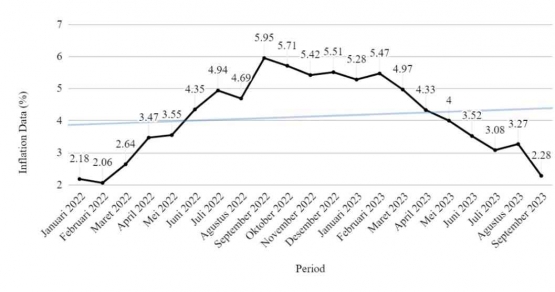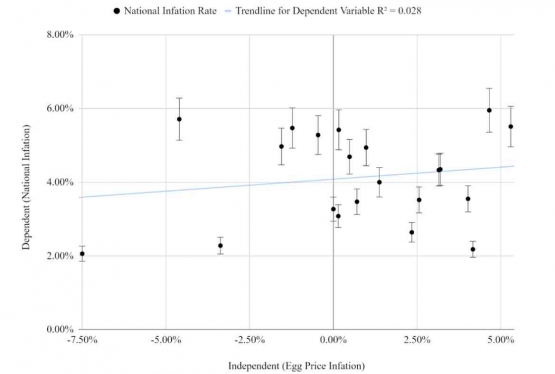
Figure 4 depicts a significant trend in the price change of eggs across traditional markets nationwide, showcasing a consistent downward trajectory. Despite the lowering piece trend, it is not translated into a decrease in its CPI baskets, food, beverages, and tobacco commodities. However, these commodities tend to maintain a higher frequency of price fluctuations, consistently remaining above the Consumer Price Index (CPI) line (Figure 5). This correlation is strongly supported by the regression analysis of Figure 7 with an R-squared value of 0.873 that indicates a strong and meaningful relationship between the National CPI and Egg Prices.
This continual ascent in the CPI is a direct result of the commodity price changes, as demonstrated in Figure 5. A clear illustration of this phenomenon is found when we observe Figure 4, where egg prices experience a notable decline since April 2023. The repercussions of this drop become evident in Figure 5, as it coincides with a decline in the past four months, creating an almost synchronous effect on both Price Change and CPI. This alignment generates a ripple effect that is typically realized within a month or two.

Nonetheless, it is crucial to note that egg prices alone cannot singularly dictate the inflation rate. This is exemplified in Figure 6, where an intriguing deviation from the expected pattern occurs. For instance, in September 2022, despite the inflation rate reaching its highest point, egg prices were, in fact, declining sharply. Nowadays, the change of egg price and inflation rate seem to be, hand-in-hand, adjusting back to when they were before 2022, getting back to its initial price/rate.
On top of that, after a the R squared (linear regression) of the national inflation rate (as the dependent variable) and the price change of eggs (as the independent variable) reveals a weak association of 0.028, which indicates that only 2.8% of the variance in the national inflation rate can be explained by changes in the price of eggs. In other words, the relationship is very weak and not practically significant (Figure 8). Thus, this particular case shows the intricate and multifaceted nature of inflation, where various economic factors and commodity price movements collectively contribute to the overall inflation rate, not just one basket of CPI.

4. The Hike of Egg Price is A Global Trend? United States Unprecedented Bird Flu Outbreak
According to PBS News (2023), in the U.S., the price of eggs more than doubled between the start of 2022 and its peak in January 2023, mainly due to a widespread bird flu outbreak. While pandemic and inflation have played a role, bird flu has been the primary driver. This outbreak caused a significant reduction in egg supply while demand remained constant, leading to higher prices. Even if the bird flu were to disappear today, egg prices would remain relatively high due to increased labor, transportation, and chicken feed costs driven by inflation. Although egg prices are decreasing, they have not returned to pre-pandemic levels.
The ongoing bird flu outbreak has resulted in the deaths of millions of egg-laying chickens, creating an egg shortage. Projections suggest a 26.8% decrease in wholesale egg prices for 2023, with a 4% increase in egg production as flocks recover. In August 2023, a dozen large, Grade A eggs were about 2.4% cheaper than the previous month. Compared to a year ago, egg prices have dropped by 34.6%, from $3.12 in August 2022 to $2.04 in August 2023 (Figure 9).


















